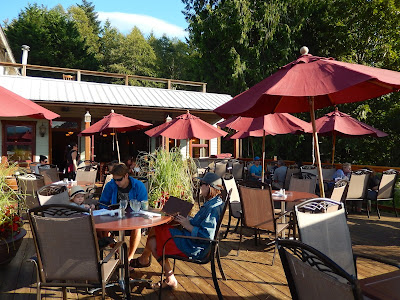
My cucumber plant has been struggling, but I found two yellowing ones hiding underneath the leaves and one nice new one near the top. The yellow ones weren't good for eating raw, so I decided to make all of them into pickle relish. I couldn't find a recipe that small, so I took one from my Farm Journal's Freezing and Canning Cookbook and adjusted it down.
Small Batch Pickle Relish
3 medium cucumbers (2 cups) diced
1/2 cup chopped onion
1/2 cup chopped mild peppers
1 tablespoon pickling salt
1/2 cup cider vinegar
1 tablespoon yellow prepared mustard
scant 1/4 teaspoon celery seed
1/4 teaspoon mustard seed
scant 1/8 teaspoon nutmeg
scant 1/8 teaspoon black pepper
scant 3/4 cup sugar
 |
| Dice the vegetables. |
You can use a food grinder or processor set on course. Up at the cabin I chose to use the old fashioned manual method, a sharp knife.
 |
| Make a brine and soak vegetables. |
Finely dice the cucumbers, onion and peppers. I used my homegrown dried onions (the small ones get used first) and a mix of banana peppers and one Anaheim chili.
 |
| Strain and rinse away excess salt. |
Dissolve the pickling salt in two cups of water. Do not use table salt because it has additives and iodine that can turn pickles dark and unappetizing.
Cover the vegetables in the brine and let them rest in the refrigerator for a minimum of three hours.
Strain the vegetables and rinse them well to remove excess salt. Use
nonreactive utensils, bowls, strainers and pans to prevent the acidic ingredients from taking on a metallic taste.
 |
| Mix the vinegar, sugar and spices. |
Mix the vinegar, sugar and spices in a non-reactive sauce pan. I used the enamel lined pot that I found at the thrift store for $2 several years ago.
 |
| Simmer until vegetables are tender. |
Add the vegetables and simmer over medium heat until they are tender and the liquid has reduced to a thick sauce.
 |
| Follow safe canning procedures. |
It was a really hot day so I used our outdoor BBQ for the cooking portion of this recipe. And the view wasn't half bad standing there to stir the mixture to keep it from sticking to the bottom.
 |
| One half pint in my small canner. |
If you eat a lot of pickle relish, you can let the mixture cool and store it in the refrigerator.
If you want to preserve your pickle relish for longer storage, use the water bath method (
click here for step-by-step directions) and process for 10 minutes (
adjust as necessary for your elevation).
Since I do small batch canning, I invested in a
Norpro Asparagus Stainless Steel Cooker/Steamer. It
doubles as a small canner that can hold one half pint or one pint with the required one inch of water over the lid. I cook with propane (even in the kitchen), so I don't have to heat or maintain a large volume of water at a rolling boil for small batches.
And there you have it. A small batch of great tasting pickle relish. This recipe will give you two half pints, or one pint. I processed one for saving and put the second in the fridge for immediate use.
My dad would have been proud of me. He was the pickle and relish maker in our city-folk family. The funny thing is that I don't remember watching him do it.
 |
| The finished pickle relish. |
Do you make pickles or relishes? What are some of your favourite recipes? Do you have to adjust recipes for small batches? -- Margy




























































